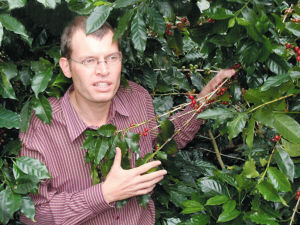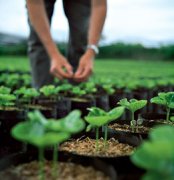Nestle Hute: discovery of Coffee "New World" in Yunnan

Hua Honglin, a man from Ninger, has taken the lead in growing coffee and has grown it into "Hua million" in 15 years.
Belgian Wu especially works all the year round: driving a dark green Beijing Gyibug with a license plate number "Yun J25151", hovering on the mountain road in Pu'er area of Yunnan Province. With the unique hot flashes of the tropical mountain monsoon climate in the airtight car, it usually takes two hours to get to the nearest village, and the lonely, repetitive itinerary is unbearable, but Huth never gets tired of it.
"I knew from the beginning that I preferred rural life." As he said, he stretched out his arm and greeted the farmers who passed along the way.
Everyone calls him "Mr. Coffee."
Hute, 35, is called "Mr. Coffee" by Pu'er people. His occupation is the coffee agronomy manager of Nestl é in Yunnan. This identity is quite similar to that of McTee, the first Christian missionary who traveled to Yunnan on foot via Sichuan and Guizhou in 1877, the former dedicated to finding God's new people in this remote area. Huth and his small team of seven maintained the cooperation between small farmers in this traditional tea producing area and Nestle's "coffee empire".
It is Nestl é's custom to search for a new world of coffee around the world: South America is a traditional coffee producer, accounting for nearly half of the world's production. The coffee harvest in Brazil alone will directly affect the prices of large coffee producers such as Nestl é, Kraft and Procter & Gamble. In 1994, Brazilian coffee suffered frost, causing the price of coffee beans to triple in two weeks, nearly dragging down the fledgling Starbucks. In order to spread the risk as much as possible, these giants have been relying on "messengers" like Hute to evenly distribute the coffee bases in their "territory".
Since 1988, Nestl é has chosen Pu'er (then also known as Simao) to grow coffee. The town, with a population of less than a million at the time, was located near the Tropic of Cancer, with suitable soil conditions and at the same latitude as Cuba, the hometown of coffee. Since ancient times, tea has been one of the main industries in the area, and the coffee culture is zero. Since 1992, Nestl é has set up a coffee agriculture service department here, and has sent five foreign experts to guide farmers to grow coffee (Huth is the fifth). By 1997, Nestl é's Dongguan coffee factory had been able to obtain all the small seed coffee beans (high quality washed coffee beans) needed from Pu'er, and it had become one of the more than 80 planting and production bases in Nestle's global coffee "territory". Contrary to the practice of multinationals, Nestl é does not want to rely too much on local farms or large middlemen. By 2009, 98% of Nestl é's suppliers in Pu'er were coffee growers rather than coffee middlemen, 80% of whom were small farmers with land below 50 mu. Nestl é hopes that this model will continue to expand with the promotion of Huth and his seven-member team.
He thinks Pu'er is the "city center" where cheese can be bought.
As a "Mr. Coffee" in the eyes of farmers, Hute used to dress up as glasses, shirts, jeans, hiking shoes, and put on a Little Red Riding Hood with Nestle logo when he went to the field. Growing up in Africa, he looked like a fish in water in the scorching sun of Yunnan. "when I was majoring in tropical agriculture at university in Belgium, I couldn't take the bus, I wasn't used to square concerts, and I couldn't talk about politics or art with people at the university." After graduation, he was offered a job with the NGO Farmers Association of Belgium and went to Africa. During his five years in Tanzania, where there was no electricity, no roads, no water, no Internet, and ate a lot of bananas every day, Hute discovered his favorite work and lifestyle: close contact with local farmers for field guidance.
Subsequently, Hute realized this ideal during his five years in China: to him, Lijiang was just a noisy "big supermarket", Kunming was the "intermediate station" for connecting flights, and Pu'er was the "heart of the city" where cheese could be bought. Huth made his home on the farm and didn't move to the town apartment with his wife and daughter until a year ago. "the dogs and chickens on the farm are too noisy." "at first there were two chickens, but now there are 20," he said. "they are always quarrelling so that my daughter can't sleep." His daughter, who is two years old, takes it for granted that her father produces all the coffee in the world.
"she always points to the coffee on display in the supermarket and calls it" Coffee Daddy! " Coffee! Dad!) "
It is too early to discuss whether the lineage of Huth's "coffee family" can continue in this little girl with blond hair. But in 2005, Hute followed his father's work and came to Pu'er. His father, Jan De Smet, is Nestl é's fourth expert in Yunnan. Before directing coffee cultivation for Nestl é in the Philippines and Yunnan, Yang spent 21 years as a coffee agronomist in Burundi, Africa, until the civil war forced him to move. During his 18 years in Africa, Wu has come into contact with coffee farmers and the whole process of coffee cultivation and processing. This experience made a deep impression on the people at headquarters when he took over from his father.
He has to lose weight every shopping season.
The warehouse area Nestl é rented in Pu'er is next to the Little Red House where Huth and his team are located, and one can hold 1200 to 1400 tons of coffee. The peak is 6000 tons when the warehouse is full, covering nearly 60, 000 mu of land, accounting for 1. 3% of Yunnan's coffee production. In the purchasing season that ended in May and June 2010, Nestl é bought about 3000 tons of coffee beans.
At the beginning of summer, Huth was always in a hurry from the office to the warehouse. In this traditional peak coffee purchasing season, small farmers use tricycles, motorcycles, tractors and vans to deliver 10 to 20 packets of coffee beans (one bag is 70 kilograms) to Nestl é purchasing stations, while suppliers of more than 100 packs hire trucks. There are long queues in front of the warehouse, which are unloaded and sorted by a team of specialized porters employed by Nestle. The main work of the insiders of the purchasing station is sampling and testing. Farmers only need to wait half an hour to know whether their coffee beans are qualified or not. Each packet of coffee beans received is repackaged and tagged to facilitate quality tracing, which is one of the reasons why Nestl é likes to do business directly with farmers. If there is a quality problem, Nestle's Dongguan factory will report this number to the purchasing station, which can be traced to the original supplier.
"in fact, I can recognize the origin and owner of the coffee as soon as I look at the driver." Huth said. He oversees the acquisition process of handling, weighing, sampling, feedback and reloading between the warehouse and the testing room in the office all day.
"our people lose weight every season. I lost 10 kilograms last year.
"Huth is so serious about his work that he won't miss any of the cups." Luo Yicheng, coffee purchasing officer of Nestle Agricultural Service Department, said. The so-called "cup product" is Nestl é's test on the quality of coffee beans: samples of coffee beans sampled at random should be fried and ground in batches after selection, and then boiled into coffee to taste. This is not the casual coffee that most people imagine, but more like a strict flow task: each person takes a spoonful from the coffee cup, takes a sip, spits it out, turns the table, and drinks another cup. At the same time, fill in the instant feeling indicators into the form: coffee aroma, fruit acid (the unique index of small-grain coffee, the higher the better), glycol, and so on.
The key point of coffee taste is mellow. " Hute said, "but what is clear alcohol, you have to try thousands of times to master." At the peak of the acquisition, Huth and his team drank 120-150 cups a day.
Important Notice :
前街咖啡 FrontStreet Coffee has moved to new addredd:
FrontStreet Coffee Address: 315,Donghua East Road,GuangZhou
Tel:020 38364473
- Prev

Coffee in Vietnam is also famous in the world.
I didn't know until I arrived in Vietnam that Brazil is the kingdom of coffee, but Vietnam's coffee is also famous in the world. The Vietnamese love coffee, just as the Chinese love tea, it is a kind of love and fascination that goes deep into the bone marrow and brings from the blood, perhaps it is that cup of coffee that gradually bakes out the gentle and easygoing patience of the Vietnamese people. Pure Vietnamese coffee is drip coffee, there is a special drip coffee pot, coffee
- Next

Pu 'er Kannong has been planted into "Hua Million" in 15 years
On the afternoon of 26 th, Hua Honglin arrived in white POLO in Munaihe District, Pu 'er City Industrial Park, which was in full swing. The 42-year-old man was athletic and dressed in Adidas. As the earliest coffee farmer in Pu 'er area, as the village party secretary of Dakaihe Village, Pu' er, a coffee professional village, he has been interviewed by more than 100 media, and the farthest reporter
Related
- Detailed explanation of Jadeite planting Land in Panamanian Jadeite Manor introduction to the grading system of Jadeite competitive bidding, Red bid, Green bid and Rose Summer
- Story of Coffee planting in Brenka region of Costa Rica Stonehenge Manor anaerobic heavy honey treatment of flavor mouth
- What's on the barrel of Blue Mountain Coffee beans?
- Can American coffee also pull flowers? How to use hot American style to pull out a good-looking pattern?
- Can you make a cold extract with coffee beans? What is the right proportion for cold-extracted coffee formula?
- Indonesian PWN Gold Mandrine Coffee Origin Features Flavor How to Chong? Mandolin coffee is American.
- A brief introduction to the flavor characteristics of Brazilian yellow bourbon coffee beans
- What is the effect of different water quality on the flavor of cold-extracted coffee? What kind of water is best for brewing coffee?
- Why do you think of Rose Summer whenever you mention Panamanian coffee?
- Introduction to the characteristics of authentic blue mountain coffee bean producing areas? What is the CIB Coffee Authority in Jamaica?

